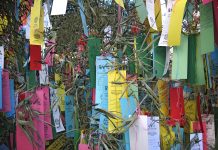Vaisakhi (also spelled Bhaisakhi) is a joyful festival on April 14, celebrating the founding of the Sikh community known as the Khalsa. While it historically was a celebration in Punjab, India of the first harvest, after 1699, the day came to commemorate the founding of the Sikh community by Guru Gobind Singh.
The celebration begins with Sikhs donning their nice clothes and visiting Gurdwara (Sikh place of worship), where they participate in special prayers, sing songs and share a meal in the langar hall (community hall). Another main event is the parade where men, women and children participate with music, dance, colors and playful Gatka duels (a weapons-based Sikh martial art). People also visit with family and friends and exchange sweets or gifts.
The founding of the Khalsa has a rich history with all the usual elements of religious history: sacrifice, repression, courage and strength. The story begins with the martyrdom of Guru Tegh Bahadur, the ninth Guru. He was publicly beheaded by Mughul rulers, who wanted to spread Islam throughout India, for protecting freedom of worship for both Sikhs and Hindus. Guru Tegh Bahadur sacrificed his life for the freedom of all, not just his own group of Sikhs.
Guru Tegh Bahadur’s son, Gobind Rai (who later became known as Guru Gobind Singh), became the tenth Sikh Guru. He was devoted to his father’s cause and stated that Sikhs should always be prepared to stand up for their beliefs, whatever the cost. It was Guru Gobind Rai who decided to change the celebration of Vaisakhi. On Vaisakhi Day in 1699, after addressing a huge crowd, he asked for people willing to sacrifice themselves, flashing his sword. One person volunteered, whom the Guru took inside a tent. The Guru emerged with his sword wet with blood and he asked for another volunteer. Three more people stepped forth and each time, the Guru emerged from the tent with a bloody sword.
Finally, one more person entered the tent and just as people began to fear, all five men emerged dressed in white and wearing turbans. These five, the panj piaray (five beloved ones) became the first members of the Khalsa and it was from that point, the turban became a symbol of the Sikh identity, representing the fight against oppression and courage. After initiating the five, Guru Gobind Singh then requested that they initiate him through the same process. The Guru gave his new Khalsa a unique identity both through the clothing and turban, and also through the five emblems of purity and courage, worn by all Sikhs, known today as the Five Ks: Kesh, unshorn hair; Kangha, the wooden comb; Karra, the iron (or steel) bracelet; Kirpan, the sword; and Kachera, the undergarment. He also gave the surname of Singh (Lion) to every Sikh man, including himself, and Kaur (Princess) to every woman. By making the Sikh identity very visible, he prevented adherents of the faith from hiding behind cowardice and encouraged Sikhs to live lives of courage, sacrifice, and equality.
For further reading:
http://www.sikhiwiki.org/index.php?title=Vaisakhi
http://www.baisakhifestival.com/baisakhi-celebrations.html
http://www.sikhismguide.org/vaisakhi.shtml



































I appreciate this website bringing positive media about Sikhs. It’s refreshing to see stories that don’t consist of the hackneyed themes “Sikhs are not Muslims” or “how quaint a religious philosophy that teaches universal egalitarianism, if only they realized the error of their ways in not having a central figure/prophet/messiah at the center.” It is indeed great to see some depth being brought to the discussion of the Sikh Dharma. However, I have to point out that there are several factual inaccuracies in this article.
The first (and most glaring) is the number of people who entered the Guru’s tent was five, not four. They are known as the panj piaray or “five beloved ones”. To this day a “panj” (a group of 5) is still a powerful form of organization respected by all Sikhs. The next error is that Guru Gobind Singh was part of the original Khalsa, he initiated the panj piaray, and then requested that they initiate him through the same process. Thus setting a democratizing precedent rarely seen amongst other faith groups. Guru Gobind Singh made it clear that we were not to worship him, but the one universal god, whom all worship, and is accessible to all and all-pervading.
Another point of note, although it’s not necessarily an inaccuracy, is the phrase “[l]eadership passed from father to son”. While there were several Sikh Gurus that were of familial relation, and Guru Gobind Singh was Guru Teg Bahadur’s son, the next Guru was traditionally chosen as the most devoted student of the previous Guru.
I hope you can fix these inaccuracies, and I look forward to more articles relating to the Sikh Dharma.
Thank you.
p.s. I’m the one prominently featured (left-most) in the photo above, and the instrument that I’m playing is called a rabab. My brother is to my left and his instrument is known as the dilruba.
Thank you Hari for alerting us to these mistakes. Although we always have people within each faith proofread these descriptions before they are published, sometimes things do get missed in proofing. We have updated the description and appreciate your feedback!
may the 4th be with u peaps